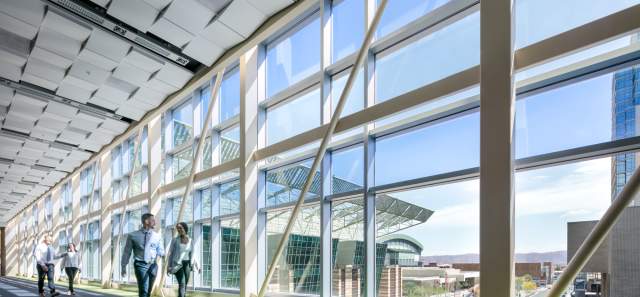American born architect, Frank Lloyd Wright, was arguably one the most significant modern architects of the 20th Century – and over 10 of his architectural works call Greater Phoenix home. The Sonoran Desert flora structured his architecture, as Wright believed architecture was organic, integral and 'of the desert.' The desert was a source of education for the famed architect, something often referred to as a biomimetic learning process.
It was in 1928 that Wright first arrived in Arizona to complete design consultations for the iconic Arizona Biltmore hotel. The legend almost immediately became smitten with the Sonoran Desert and its distinct landscape. Just nine years later, Wright established Taliesin West, utilizing it as his winter home and personal studio.
- Arizona Biltmore Hotel (1929)
- Taliesin West (1937)
- Benjamin Adelman House (1950)
- Boomer Cottage (1953)
- David & Gladys Wright House (1951)
- Harold Price, Sr. House (1954)
- Norman Lykes House (1959)
- Gammage Auditorium at ASU (1959)
- First Christian Church (1972)
- Privately-Owned: Raymond Carlson House (1950), Pieper House (1952)
- Frank Lloyd Wright Spire (2004)
Arizona Biltmore Hotel (1929)
Back to Top of ListFrank Lloyd Wright has influenced countless designs in the world, with one of the few hotels globally able to make that claim being the Arizona Biltmore. Designed by Albert Chase McArthur, a Harvard graduate who studied under Frank Lloyd Wright in Chicago. The hotel was crowned “The Jewel of the Desert,” and has been an Arizona landmark since its opening in February 1929. Wright had a particular preference for indigenous materials, inventing a pre-cast, decorative concrete block known today as the “Biltmore Block.” The pattern on the blocks is said to represent the refraction of light. The iconic architect’s famous touch can also be seen throughout Arizona Biltmore, including balconies, spires, one of the largest gold-leaf ceilings in the world and a roof constructed of over 16 tons of copper. In 1973, Wright’s saguaro cactus graphic was selected from the Frank Lloyd Wright Archive to be rendered in stained glass in the reconstructed foyer after there was a fire in the Arizona Biltmore. The hotel was extremely successful at attracting big names and celebrities from around the world. Is it alleged that guests walking through could see Marilyn Monroe by the pool and Frank Sinatra at the bar. Rumor has it that Irving Berlin even penned “White Christmas” while sitting beside the original swimming pool. And to top it all off – Arizona Biltmore’s master bartender, Gene Sulit, is credited with inventing the Tequila Sunrise in the 1930’s at The Wright Bar.
(2400 East Missouri Avenue, Phoenix, AZ. If you are thinking of exploring some of the Wright-designed buildings in the Phoenix Metro area, check availability and rates at the Arizona Biltmore’s website.)
Taliesin West (1937)
Back to Top of ListTaliesin West was one the first of many architectural schools that Frank Lloyd Wright founded, originally known as the Taliesin Fellowship. It became a major hub for education and research and was comprised of apprentices who studied and worked alongside Wright at the beloved site. The Fellowship was founded in 1937 when Wright purchased the foothills of McDowell Mountain and continued until Wright’s death in 1959. It included a diverse group of students from all over the world, who were committed to learning Wright’s philosophy of architecture. In Wright’s own words, Taliesin West would be “a look over the rim of the world“, serving as an architectural laboratory for him for the next 20 years. Wright passed on April 9, 1959 in Phoenix where his iconic winter estate and school in the desert began in 1937. Today it is the main campus of the School of Architecture at Taliesin and houses the Frank Lloyd Wright Foundation. On July 7, 2019, UNESCO announced the addition of Taliesin West along with seven other Frank Lloyd Wright designed buildings to the United Nations’ list of the world’s most significant cultural and natural sites.
(12621 Frank Lloyd Wright Boulevard, Scottsdale, Arizona. Browse the various tours online and book at franklloydwright.org.)
Benjamin Adelman House (1950)
Back to Top of ListThe Benjamin Adelman House was constructed in 1952 from a design Frank Lloyd Wright had completed in the 1940s. The original floor plan presented a 700 square-foot main house with living and dining space, workspace, a master bedroom, and bath, along with a 500 square foot guest house behind the main house. It was unique partially due to the fact that it featured a carport – Frank Lloyd Wright’s invention. The Adelman home was built by local Native Americans for the Milwaukee, Wisconsin businessman as a winter residence at a cost of $25,000. It sold in 2002 for 1.2 million dollars and has undergone extensive renovation and change, with the square footage now over 3,360 square feet.
(Privately owned and not available for tours. Please respect the owners’ right to privacy and do not trespass on the property.)
Boomer Cottage (1953)
Back to Top of ListThe Jorgine Boomer Cottage is adjacent to the Adelman property. It is alleged that the Adelmans and Boomers met at the nearby Biltmore Hotel and often played bridge together and sometimes with Mamie Eisenhower!
(Privately owned and not available for tours. Please respect the owners’ right to privacy and do not trespass on the property.)
David & Gladys Wright House (1951)
Back to Top of ListDavid Wright, the son of Frank Lloyd Wright, was a sales rep for a concrete block company. The house his father curated for him was built in 1951 and is tucked away amongst citrus groves. The property sits on a circular style two-acre plot, with its entrance and living quarters elevated to the second level. Wright thought that by elevating the living space, one could take advantage of the desert breezes. Having lived in the home their entire lives, Frank’s son David and his wife Gladys lived at the property until Gladys passed away in 2008. Shortly after, Wright heirs placed the home for sale and it sold for cash the next year at $2.8 million. The new owners allegedly have plans to restore the home to its original condition.
(5212 E Exeter Blvd, Phoenix, Arizona. The David Wright House is not currently open to the public for tours.)
Harold Price, Sr. House (1954)
Back to Top of ListIn 1952, Harold Price, Sr. had visited Taliesin West to discuss building a multi-story structure in Bartlesville, Oklahoma. The result was a commission to build the 19-story, 221-foot-tall Price Tower. In 1954, – the Price Residence was built on nine acres along a hill in Paradise Valley.
(7211 North Tatum Blvd, Paradise Valley, AZ. Privately owned but is occasionally open for tours. Contact info@pricehousefoundation.org for more information.)
Norman Lykes House (1959)
Back to Top of ListThe Norman Lykes House’s design is based on circles, coming from a time very late in Frank Lloyd Wright’s life when had embraced circular geometry. The sketches for this house were the last to come from the great architect. Wright passed in April 1959, before the design was complete. The home’s concept seemingly blends into the mountain itself, one of the philosophies of organic architecture that Wright embraced until the end of his career. In January 2023, the Lykes House was put up for sale at $8,950,000 and as of November 2023, was still listed for sale.
(6836 N 36th St, Phoenix, AZ 85018. Currently listed for sale.)
Gammage Auditorium at ASU (1959)
Back to Top of ListGammage Auditorium at Arizona State University is a Wright-designed building named for Dr. Grady Gammage, the college’s ninth president. Serving from 1933-1959, Grady is the legendary ASU president who led Arizona State College’s campaign in the state legislature for a name change to Arizona State University. The Auditorium is considered by many to be the crown jewel of ASU’s Tempe campus, was constructed to be as acoustically perfect as possible, and is one of Frank Lloyd Wright’s last designs. Grady Gammage passed away in 1959, the same year as Frank Lloyd Wright, and never had the chance to see the finished structure.
(1200 S Forest Ave, Tempe, AZ. Building tours of the Gammage Auditorium are available by appointment. If you would like to tour ASU Gammage email tours@asugammage.com.)
First Christian Church (1972)
Back to Top of ListAt 82 years old in 1949, Frank Lloyd Wright was commissioned to design a Classical University at First Christian Church. Complete with a chapel and all, the campus would occupy eighty acres. His drawings were completed and revealed to the public in 1950. The church, however, ceased operations and thus the university was never built. Eventually, permission was obtained from Wright’s widow to use the plans for a new First Christian Church, and the church was officially completed in 1973. The church spire rises seventy-seven feet to the heavens and the building features a red tile with Mr. Wright’s signature imprinted on it. Five years after its completion, Wright designed a free-standing, 120-foot bell tower and 22-foot cross – some of the most unique of Wright’s designs.
(6750 N 7th Ave., Phoenix, AZ. No scheduled tours available. Contact the church office for more information or respectfully attend a service to view the building in use as it was intended.)
Privately-Owned: Raymond Carlson House (1950), Pieper House (1952)
Back to Top of ListAlso scattered throughout the Greater Phoenix area, you will find privately-owned Wright gems like the Raymond Carlson House (1950), Pieper House (1952) and more.
Frank Lloyd Wright Spire (2004)
Back to Top of ListIn the heart of Scottsdale rises a 125-foot tower that was a part of a design that architect Frank Lloyd Wright proposed in 1957 as Arizona’s new State Capitol in Papago Park. The design was rejected by Arizona for being too “modern,” and for many years it sat as one of the hundreds of Wright designs that were never implemented. But in 2004, the Promenade Scottsdale was looking for a focal point for its shopping center. Working with one of Wright’s apprentices, Arnold Roy, the Promenade built one of Wright’s Capitol design elements on the corner of Frank Lloyd Wright Boulevard and Scottsdale Road. The spire is constructed from 1,700 individual pieces of steel, weighs over 37 tons and is about seven miles northwest of Taliesin West.
(7207 E Frank Lloyd Wright Blvd, Scottsdale, AZ 85260. Available to view anytime.)
Editor's Picks
Midcentury Neighborhoods
Channel your inner architecture geek in the city's timeless midcentury modern neighborhoods.
Unexpected Phoenix Attractions
Who knew you could find bats, a castle, a Japanese garden and more in the greater Phoenix area?…
The Best Guided Tours in Phoenix
Whether you're looking to explore art, architecture, food, or the great outdoors, you'll find…







